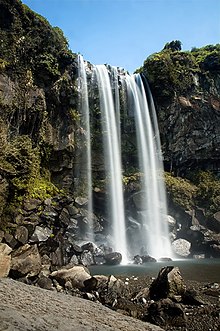Jeongbang Waterfall
| Jeongbang Waterfall | |
 | |
| Korean name | |
|---|---|
| Hangul | 정방폭포 |
| Hanja | 正房瀑布 |
| Revised Romanization | Jeongbang Pokpo |
| McCune–Reischauer | Chŏngbang Pokpo |
Jeongbang Waterfall is a famous waterfall on Jeju Island.[1] The waterfall is 23 m (75 ft) high and is very close to the ocean.[1][2] Depending on the level of recent rainfall, it can be up 8 m (26 ft) wide.[3] The source of the waterfall is the stream Donghong-chun.[4] Located near Seogwipo, Jeongbang Waterfall is a popular tourist attraction.[5] It is considered Yeongjusipgeong, one of the ten greatest scenic wonders of Jeju.[5]
Legend states that a holy dragon lived underneath it.[6] It was said that the dragon's spirit is contained in the water which can cure diseases and bring rain during drought.[6] Furthermore, a nearby small waterfall is said to resemble a servant waiting on a lord.[6]
A legend states that Emperor Jin of China (259 BC - 210 BC) sent a servant, Seobul, to fetch the magical herbs of eternal youth from Mount Halla.[7][5] Though he failed to find the herb, he encountered Jeongbang Falls on the way and he left his autograph, Seobul Gwaji (which literally means "Seobul was here"[8]), on the cliff wall, where it no longer remains.[5][9] An inscription on the wall of the waterfall saying "Seobulgwacha", refers to Seobul's journey.[7] The waterfall is one of the three famous waterfalls of Jeju, along with Cheonjiyeon Waterfall and Cheonjeyeon Waterfall.[5] A smaller waterfall, Sojeongbang Waterfall is 300 m to the east.[1][7][5]
The waterfall is also known to be a location related to the Jeju uprising, where in 1948, six massacres were committed and the bodies were disposed of downstream over the watefall.
See also
References
- ^ a b c Lee, Cecilia Hae-Jin. (2008). Frommer's South Korea. Hoboken, NJ: Wiley. pp. 392. ISBN 978-0-470-18191-1.
- ^ lifeinkorea.com. "Jeongbang Waterfall". Archived from the original on 2011-06-12. Retrieved 2011-06-06.
- ^ Simon Richmond (1 May 2010). Korea. Lonely Planet. p. 297. ISBN 978-1-74104-831-5. Retrieved 7 June 2011.
- ^ Oh, Duck Chul; Choi, Young Chan; Ko, Yong Ku (1992). "An Investigation of the Water Quality of the Streams in Sogwipo City". Korean Journal of Limnology. 25 (1): 20–30.
- ^ a b c d e f "Jeongbang Waterfall in Jeju, Jeongbang Waterfall of Jeju, Korea". Retrieved 7 June 2011.
- ^ a b c Cecilia Hae-Jin Lee (24 May 2010). Frommer's South Korea. Frommer's. pp. 404–. ISBN 978-0-470-59154-3. Retrieved 7 June 2011.
- ^ a b c "Official Site of Korea Tourism Org.: Jeongbang Falls". Retrieved 7 June 2011.
- ^ "Jeju Weekly". Retrieved 7 June 2011.
- ^ "::Jeju Tour Info::". Retrieved 7 June 2011.
